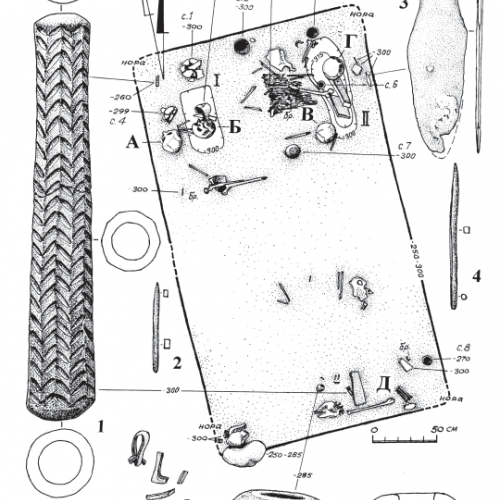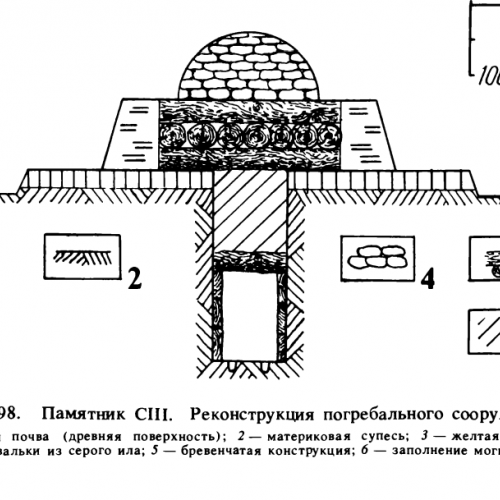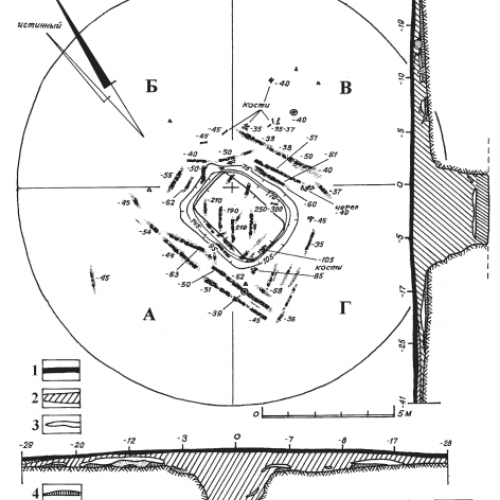Памятник был исследован археологической экспедицией под руководством В.И. Стефанова в 1970-х годах. В ходе раскопок были зафиксированы остатки надмогильного деревянного перекрытия.
В насыпи кургана и в верхних слоях заполнения могильной ямы было найдено множество костей животных, два целых сосуда и фрагменты еще двух.
Пол могильной ямы был выложен плотным и мощным слоем известковой глины. На дне ямы были обнаружены останки пяти умерших – черепа, некоторые крупные кости и фаланги пальцев.
По версии В.Ф. Генинга, Г.Б. Здановича и В.В. Генинга в погребальной камере стояла колесница, колеса которой были погружены в специальные ямки, фиксирующиеся в северной части камеры. Кости четырех погребенных были помещены в кузове колесницы, еще одного положили у противоположной стены камеры.
В.И. Стефанов и А.В. Епимахов считают, что в данном случае, имела место имитация колесницы. Либо во время обряда захоронения колесницу временно поместили в могильную яму, а затем удалили. Об этом говорит высота деревянного перекрытия – она достигала примерно 50 см. Сомнительно, что в ней могла разместиться полнокомплектная (с кузовом, дышлом). К тому же, заполнение ямок не только не содержало деревянных деталей, но было чрезвычайно плотным. Исследователи отмечают, что вариант размещения умерших в кузове не известен ни в одном синташтинском погребении.
Предметный ряд погребения включает в себя восемь сосудов – целых и фрагментированных, ряд включал в себя орнаментированное сопло, заготовки литейных форм, навершие булавы, двулезвийный нож, два шила, абразивы, ударное орудие из камня, металлический «лом», незавершенные изделия. Сложно сказать, к кому из погребенных относятся те или иные предметы.
Насыпь кургана С-III была восстановлена в 2022-2023 году командой Благотворительного фонда «Аркаим» и Заповедника «Аркаим» в рамках проекта «Синташтинский феномен» при поддержке Фондом президентских грантов.
Small Kurgan S-3
The site was excavated in 1972 as part of the Ural State University’s archaeological expedition under the direction of V.F. Gening (the excavation was supervised by V.I. Stefanov). Before the excavations the kurgan resembled a burial mound that measured 15-16 m in diameter and was 0.4 m high. In the course of the excavations, at the level of the ancient surface, archaeologists found the remnants of a 6 x 6 m structure made out of clay, logs, and other organic materials. The structure partially covered a grave. In the layers associated with the structure, as well as in the top layers of the grave’s fill archaeologists recovered a large quantity of sacrificial animal bones, along with two intact vessels and ceramic sherds belonging to two other vessels.
The architecture of the burial chamber
The grave, which was 2.3 m deep, contained a wooden chamber measuring 3.2 x 1.8 m. The walls of the chamber were 1 m high, made using split logs. The floor of the chamber was made out of a thick dense layer of limy clay. The bottom of the grave contained the remains of five individuals. The preservation of the bones was poor –archaeologists were only able to recover the skulls and finger phalanges, along with some larger bones. The chamber possibly contained a chariot, the wheels of which were placed into small depressions dug out in the northern part of the grave. A possible reconstruction of the burial ritual is as follows: the remains of four individuals were placed in the carriage of the chariot while the remains of one more individual, along with two horse heads, were placed in the opposite part of the chamber. It is possible that the presence of a chariot was symbolically imitated or that a real chariot was temporarily entered into the grave and then extracted.
Artifacts
Burial goods include eight vessels (both intact and fragmented), two ornamented blowpipes, unfinished casting molds, stone mace head, bronze double-edged knife, two bronze awls, abrasives, a stone striking tool, and metal waste.




